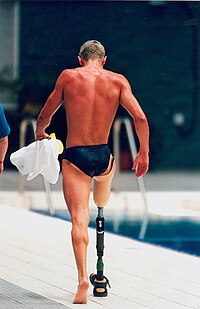
Photo from wikipedia
In post-amputation rehabilitation, a common goal is to return to ambulation using a prosthetic limb, suspended by a customised socket. Prosthetic socket design aims to optimise load transfer between the… Click to show full abstract
In post-amputation rehabilitation, a common goal is to return to ambulation using a prosthetic limb, suspended by a customised socket. Prosthetic socket design aims to optimise load transfer between the residual limb and mechanical limb, by customisation to the user. This is a time-consuming process, and with the increase in people requiring these prosthetics, it is vital that these personalised devices can be produced rapidly while maintaining excellent fit, to maximise function and comfort. Prosthetic sockets are designed by capturing the residual limb’s shape and applying a series of geometrical modifications, called rectifications. Expert knowledge is required to achieve a comfortable fit in this iterative process. A variety of rectifications can be made, grouped into established strategies [e.g. in transtibial sockets: patellar tendon bearing (PTB) and total surface bearing (TSB)], creating a complex design space. To date, adoption of advanced engineering solutions to support fitting has been limited. One method is numerical optimisation, which allows the designer a number of likely candidate solutions to start the design process. Numerical optimisation is commonly used in many industries but not prevalent in the design of prosthetic sockets. This paper therefore presents candidate shape optimisation methods which might benefit the prosthetist and the limb user, by blending the state of the art from prosthetic mechanical design, surrogate modelling and evolutionary computation. The result of the analysis is a series of prosthetic socket designs that preferentially load and unload the pressure tolerant and intolerant regions of the residual limb. This spectrum is bounded by the general forms of the PTB and TSB designs, with a series of variations in between that represent a compromise between these accepted approaches. This results in a difference in pressure of up to 31 kPa over the fibula head and 14 kPa over the residuum tip. The presented methods would allow a trained prosthetist to rapidly assess these likely candidates and then to make final detailed modifications and fine-tuning. Importantly, insights gained about the design should be seen as a compliment, not a replacement, for the prosthetist’s skill and experience. We propose instead that this method might reduce the time spent on the early stages of socket design and allow prosthetists to focus on the most skilled and creative tasks of fine-tuning the design, in face-to-face consultation with their client.
Journal Title: Biomechanics and Modeling in Mechanobiology
Year Published: 2019
Link to full text (if available)
Share on Social Media: Sign Up to like & get
recommendations!